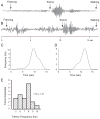Non-human primate FOG develops with advanced parkinsonism induced by MPTP Treatment
- PMID: 22967858
- PMCID: PMC3582410
- DOI: 10.1016/j.expneurol.2012.07.021
Non-human primate FOG develops with advanced parkinsonism induced by MPTP Treatment
Abstract
Freezing of gait (FOG) is a debilitating feature of Parkinson's disease (PD) and other forms of parkinsonism. The anatomical or pathophysiological correlates are poorly understood largely due to the lack of a well-established animal model. Here we studied whether FOG is reproduced in the non-human primate (NHP) model of PD. 1-methyl-4-phenyl-1,2,3,6-tetrahydropyridine (MPTP)-treated monkeys (Genus Macaca, n=29) were examined for the development of FOG, and the leg movements were recorded with accelerometry. The relationships between developing FOG and the animals' characteristics, the MPTP treatments, and the modeled outcomes were determined. In parkinsonian monkeys FOG developed frequently (48%) manifesting similar characteristics to those seen in PD patients. In addition, FOG episodes in the monkey were accompanied by leg trembling with the typical duration (2-10s) and frequency (~7 Hz). The development of NHP FOG was significantly associated with the severity of parkinsonism, as shown by high motor disability scores (≥ 20) and levodopa-induced dyskinesia scores (p=0.01 and p=0.04, respectively). Differences in demographics and MPTP treatments (doses, treatment duration, etc.) had no influence on NHP FOG occurrence, with the exception of gender that showed FOG predominance in males (p=0.03). The unique features of FOG in PD can be replicated in severely parkinsonian macaques, and this represents the first description of a FOG animal model.
Published by Elsevier Inc.
Figures


References
-
- Amboni M, Barone P, Picillo M, Cozzolino A, Longo K, Erro R, Iavarone A. A two-year follow-up study of executive dysfunctions in parkinsonian patients with freezing of gait at on-state. Mov Disord. 2010;25:793–795. - PubMed
-
- Bartels AL, Leenders KL. Brain imaging in patients with freezing of gait. Mov Disord. 2008;23 (Suppl 2):S461–S467. - PubMed
-
- Bloem BR, Hausdorff JM, Visser JE, Giladi N. Falls and freezing of gait in Parkinson’s disease: a review of two interconnected, episodic phenomena. Mov Disord. 2004;19:871–884. - PubMed
-
- Cao X, Liang L, Hadcock JR, Iredale PA, Griffith DA, Menniti FS, Factor S, Greenamyre JT, Papa SM. Blockade of cannabinoid type 1 receptors augments the antiparkinsonian action of levodopa without affecting dyskinesias in 1-methyl-4-phenyl-1,2,3,6-tetrahydropyridine-treated rhesus monkeys. J Pharmacol Exp Ther. 2007;323:318–326. - PubMed
-
- Devos D, Bordet R, Defebvre L. Pharmacological hypotheses and therapeutic strategies for gait disorders in Parkinson’s disease. Rev Neurol (Paris) 2010;166:168–177. - PubMed
Publication types
MeSH terms
Grants and funding
LinkOut - more resources
Full Text Sources
Other Literature Sources
Medical

